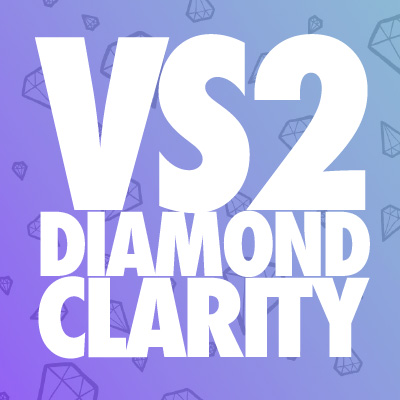VS2 Diamonds
Everything you need to know about VS2 clarity diamonds
Ringspo is reader supported
Ringspo is reader-supported, which means we may receive a commission if you click a link to a retailer & subsequently make a purchase.
We feature links to several retailers to help readers find the one that is the best fit for them. Find out more about how Ringspo works here.
VS2 diamonds are the clarity I recommend the most when helping people find the best engagement ring for their budget. And there’s one good reason for this.
The incredible balance of value and beauty they offer. When you’re buying your engagement ring, you want to get the most beautiful diamond for your budget, right? What beauty means may differ slightly from person to person, but what is not beautiful when it comes to diamonds is pretty consistent.
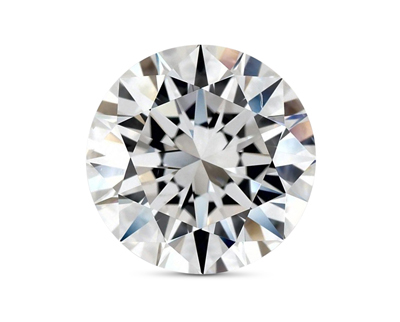
Diamonds that have big, visible inclusions in them are universally acknowledged to not be beautiful, and noticeable flaws are one of the biggest determinants of how much you can sell diamonds for, if you ever wanted to upgrade your ring in the future.
What you need is a diamond that is ‘eye clean’ ie. one that looks absolutely perfect when someone looks at it, and when doesn’t show any visible flaws or inclusions.
This is where VS2 diamonds come in. They strike the best balance between clarity and price out of any clarity grade.
VS2 diamond clarity
It’s likely that you’re familiar with the diamond clarity scale, but just in case you need a quick refresher, it looks like this:

As you can see, VS2 is in the middle of the scale.
However, you should discount ‘included’ diamonds from being considered for purchase as they all have obvious inclusions that significantly affect the beauty of the stone, even when viewed with the naked eye. Likewise, almost all SI2 graded diamonds and a large proportion of SI1 diamonds will have readily visible inclusions, which makes them less suitable for purchase.

This therefore puts VS2 diamonds towards the bottom of what would be deemed ‘acceptable’ when it comes to diamond clarity. So does this mean that they are low quality and should be avoided?
The important thing to read is the description that the GIA provides for VS-graded diamonds:
Inclusions are minor and range from difficult to somewhat easy for a skilled grader to see under 10x magnification
So, even a skilled grader, ie. a diamond professional who knows what to look for, will need a microscope to see a flaws in a VS2 diamond. A layman would find it much more difficult to see any inclusions in a VS2 diamond and without a microscope it is extremely difficult indeed.
What do VS2 diamonds look like?
VS2 diamonds are generally free from visible flaws when viewed ‘face up’ ie. with the flat ‘table’ of the stone at the top.
This is the view that diamonds are when mounted in an engagement ring and really should be the only view if you are buying your diamond to wear in jewelry, rather than as an investment.
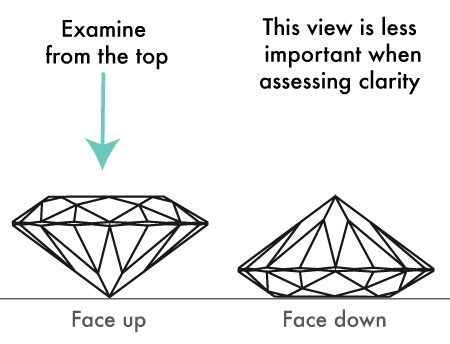
But diamonds are naturally occurring substances, and as with anything in nature, there is some variation.
In addition, diamonds are graded by real people, and there may be some variation in the standards applied. But reputable grading laboratories like GIA and AGS try very hard to ensure that grading standards are consistent over time and across different labs.
A typical VS2 clarity diamond
A typical VS2 clarity diamond might look like the diamond below:

At first glance it looks pretty good, right? No obvious inclusions or flaws visible.
The first step when assessing a VS2 diamond should be to check out the clarity plot on the diamond grading report, or certificate.
Most diamonds above 0.7 carat should have a diamond clarity plot on their grading report (also known as a certificate), which shows the types and size of the inclusions:

Zooming in, the clarity plot for the above diamond looks like this:

It lists the most obvious inclusions first – in this case, a feather, which we can see marked up in red in the top right hand corner of the stone.
Looking again, now that we know where to look, it’s easy to spot this inclusion in the diamond:
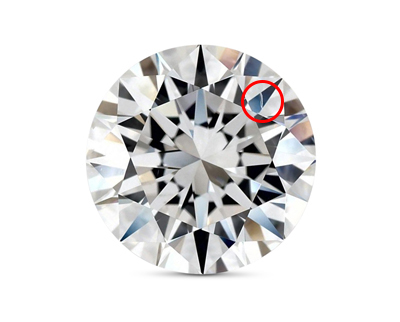
While the inclusion is readily visible on the magnified image now (and the big red circle helps, no doubt!), its location and the type of inclusion it is means that it would be very difficult, if not impossible, to see in real life when the diamond is not magnified 20x.
Are VS2 diamonds eye clean?
All diamonds that have been graded as VS2 clarity by a reputable, independent lab should be eye clean.
However, there are exceptions to this and I would advise against buying a VS2 diamond that has an inclusion directly under the table. There are a couple of ways that this could manifest itself, and each can cause a different issue:
Crystal
Crystals are remnants of other minerals in a diamond and are often sizeable and dark. A diamond clarity plot with a crystal listed first, like the one below, means that it is the most prominent inclusion and its location under the table means that this diamond needs to be examined to determine whether the diamond is eye clean:
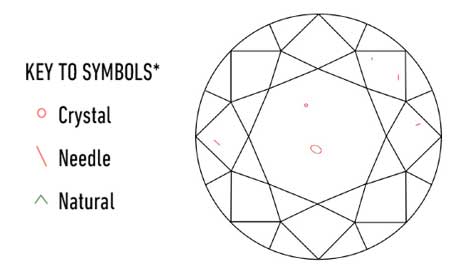
Looking at the actual image of the diamond, below, you can see the crystal inclusion is easy to see near the middle of the table:

While this is an extremely magnified image, it’s likely that this inclusion would be visible when examined closely, so I would recommend avoiding this diamond.
Clouds in VS2 diamonds
A cloud inclusion is a collection of tiny pinpoint inclusions in close proximity to each other.
Each individual pinpoint is difficult to see, but as a group they can be visible.

When a large cloud is under a table, the clarity plot on the certificate looks something like this:

Looking at an image of the actual stone, the cloud can be seen near the center of the table:
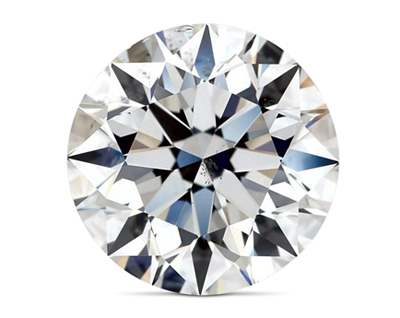
Unlike the crystal inclusion in the example above, the cloud inclusion isn’t an obvious dark spot. It’s unlikely that this would be readily visible when examined normally.
However, the issue with a cloud is that they can severely limit the amount of light that is transferred through a diamond, especially if they are located in the center of a diamond’s table, like this stone. Reducing the amount of light that is transferred through a diamond will mean that less light is available to be reflected back to your eye in the form of brilliant sparkle. For this reason, I would recommend avoiding VS2 clarity diamonds with cloud inclusions under the table.
Flaws at the edge of the stone
Some VS2 diamonds have flaws at the edge of the stone. These may be quite large and visible, even without a microscope or loupe:

However, these flaws don’t necessarily mean that a diamond should be rejected.
These types of flaws are known as ‘prongable’ as they can be hidden underneath the prong of the ring setting which holds the diamond in place.

Their location at the side of the stone means that they won’t affect the brilliance of the diamond, so finding a prongable VS2, or even an SI1, can be a good way to get more value with your diamond, without affecting the amount that it sparkles.
Difference between VS2 and VS1 diamonds
VS1 diamonds and VS2 are grouped together in the GIA clarity grading scale and are covered by the same description:
Very Slightly Included (VS1 and VS2) – Inclusions are minor and range from difficult to somewhat easy for a skilled grader to see under 10x magnification
So, what’s the difference between VS2 and VS1 diamonds?
The main difference is in the size and location of the inclusions.
- VS2 diamonds are more likely to have inclusions that are larger, darker and closer to the center of the diamond, where they are easier to see.
- VS1 diamonds are more likely to be smaller and further away from the table of the diamond, which makes them more difficult to see.
When should you choose a VS1 diamond over a VS2 diamond?
There are two occasions when you should consider choosing a VS1 diamond over a VS2 diamond:
- When the diamond has a diamond dossier, rather than a diamond report
- When the diamond is over 2 carats
Consider a VS1 when… a diamonds has a ‘diamond dossier’, rather than a diamond report
In the examples of VS2 diamonds shown above, we used the ‘clarity plots’, which map out the inclusions in a diamond, to make it easier to spot and assess the inclusions.
Having a diamond’s quality graded by an independent lab like the GIA costs money, and this expense eats into the profit margins of diamonds suppliers and retailers.
To reduce this, diamonds smaller than 1 carat are sometimes issued a simpler version of the diamond gradient report, known as a diamond dossier. A diamond dossier contains much of the same information as a diamond grading report, but doesn’t include a diamond clarity chart:

It does still list the inclusions in the ‘clarity characteristics’ section, with the most prominent inclusion listed first.
But, just having the inclusions listed means that it impossible to know where the inclusions are located in the diamond, unless you can see a high quality, zoomed-in image of the diamond in question or you can examine the stone under a microscope yourself.
The diamond for the above certificate is below, and you can see that the crystal inclusion that it is listed first is clearly visible near the center of the table.

For smaller diamonds, I therefore recommend retailers, like James Allen, who have high quality, magnified images of all their diamonds, allowing you toreview each individual diamond and verify whether or not they have prominent inclusions under the table.
For other retailers where high quality magnified images of each individual diamond aren’t available, VS2 diamonds which only have a diamond dossier should be avoided.
Consider a VS1 when… a diamond is over 2 carats
In theory, diamond clarity gradings should be the same, no matter what size or shape of diamond is being assessed. A VS2 is a VS2 is a VS2, right?
In reality, there are some exceptions and the larger a VS2 diamond is, the more care has to be taken to ensure that it is eye clean. Larger diamonds have larger top tables, and larger tables mean that there are more opportunities for an inclusion to appear underneath it and be visible.

Difference between VS2 and SI1 diamonds
‘Slightly Included’ is the diamond clarity grade below ‘Very slightly included’ on the clarity scale, and their description is:
Slightly Included (SI1 and SI2) – Inclusions are noticeable to a skilled grader under 10x magnification
SI1 diamonds are the higher grade in the slightly included grading band, which means that their inclusions are more difficult to detect than the SI2.
What does a SI1 diamond look like?
As with a VS2 diamond, there is can be a great deal of variation in SI1 diamonds. Check out the two stones below:
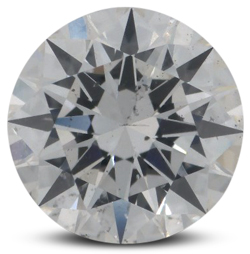

As you can see, there is a clear difference between the two. The SI1 diamond on the left has inclusions that are clearly visible, and should be avoided. The SI1 diamond on the right is likely to present as eye clean, and should be considered, if other factors with the stone (cut, pricing) are favourable.
When should you choose an SI1 diamond over a VS2 diamond?
If you can view high quality images of diamonds and can find an eye clean SI1 diamond then it is a great option. It will be less expensive and look identical when viewed in a ring.
However, finding eye clean SI1 diamonds that also have a high quality cut that is optimised to deliver as much brilliant sparkle as possible can take a little while. If you’re prepared to wait a while to find the perfect stone though, they can be a great choice.
When should you not choose an SI1 diamond over a VS2 diamond?
If you can’t see a high quality, magnified image of a SI1 diamond, or if you can’t inspect it in person then you shouldn’t consider it for purchase. You would be taking too large a risk that it would not be eye clean.
How much does a VS2 diamond cost?
As mentioned before, VS2 diamonds deliver the best blend of clarity and price.
Here’s where they sit on a price scale for a diamond with the following specs at one of my recommended retailers.
- Carat: 1
- Color: G
- Cut: excellent
| Clarity | Price (USD) | Difference (USD) | Difference (%) |
|---|---|---|---|
| F | $9,988 | $0 | 0% |
| IF | $8,408 | -$1,580 | -15.8% |
| VVS1 | $6,628 | -$3,360 | -33.6% |
| VVS2 | $6,359 | -$3,629 | -36.3% |
| VS1 | $5,960 | -4,028 | -40.3% |
| VS2 | $5,434 | -$4,554 | -45.6% |
| SI1 | $4,698 | -$5,290 | -53.0% |
| SI2 | $4,104 | $5,884 | -58.9% |
| I1 | $3,879 | -$6,109 | -61.2% |
Click here to check today’s up-to-date prices.
You can in the table that VS2 diamonds are around 10% less expensive than a VS1 diamond, and around 10% more expensive than than a SI1 clarity diamond.
They’re also a huge 45% less than an ‘internally flawless’ diamond, although if you follow the guidance on this page, the two diamond should be indistinguishable from each other with the naked eye if the other factors are the same.
VS2 clarity and diamond shape
So far in this guide I have used the round brilliant shape for all of my examples. They’re the most commonly chosen diamond shape and they sparkle the most brilliantly. However, there are 9 other commonly chosen diamonds shapes and in this section we’ll look at each one and detail the considerations that you should take into account when selecting a VS2 diamond.
It should be noted that these aren’t necessarily typical examples of VS2 diamonds in each of the shapes, rather that I have searched for extreme examples to show what to be careful of.
VS2 round brilliant diamond
Round brilliant diamonds are the shape that sparkles the most, which means that you can get away with selecting lower grades for the other quality factors. A brilliantly sparkle can hide a multitude of sins.
As we’ve see, when selecting a VS2 round brilliant diamond, the main thing to ensure is that the inclusions (either the black or the cloud) are not under the table and will therefore not be visible.
VS2 oval diamond
Oval diamonds are basically elongated round brilliant cuts, and as a result they sparkle nearly as well as round brilliant diamonds.
Where they do differ is that oval diamonds have a larger ‘table’ than round brilliant diamonds ie. the flat area on top of the diamond.
This means that any inclusions are more likely to be under the table of an oval diamond and therefore more likely to be visible. For this reason, extra care should be taken when selecting a VS2 oval diamond, with special attention paid to where the inclusions are located.
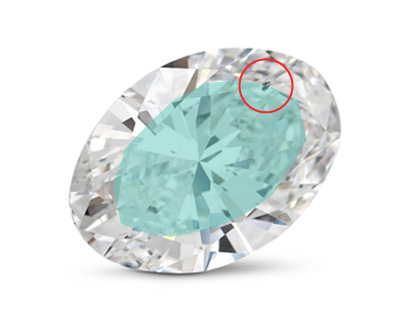
VS2 princess cut diamond
Princess cuts can be more fragile than other diamond shapes due to their straight sides and pointed corners. While diamonds are the hardest material known to man, this only refers to their ability to withstand being scratched, and if a diamond is hit where it is fragile, it can be chipped surprisingly easily.
For this reasons, inclusions close to the edge of Princess cut diamonds should be examined closely to ensure that they don’t make the stone fragile
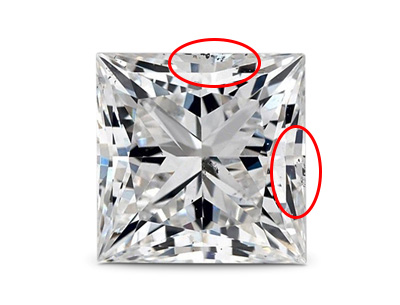
At VS2 clarity, the inclusions shouldn’t be large enough for this to be too severe an issue, but if you are looking at a VS2 princess cut diamond and would like a second opinion then please don’t hesitate to drop me a line.
VS2 Cushion diamond
Cushion cut diamonds are one of the deepest diamond cuts, which means that they have a smaller ‘spread’ than most other diamond shapes. Despite this, they still have pretty large tables which means that you need to make sure that the inclusions aren’t visible under the table.
There are several variations of the cushion cut, but one distinction that is often made is whether a cushion is ‘traditional’ (also known as ‘chunky’), or ‘crushed ice’:
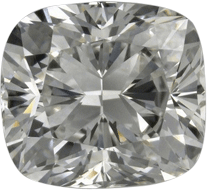
Chunky cut cushion diamond

Crushed ice cushion cut diamond
Crushed Ice cushions are better at hiding inclusions as they disappear into scintillation effect caused by the different facets.
VS2 radiant diamond
Radiant diamonds are another shape with a large top table. Like the cushion cut, radiants can have a ‘crushed ice’ effect, caused by the internal facets of the diamond. In the example below, even though there are inclusions in the center of the table, the radiant cut makes it hard to see them.
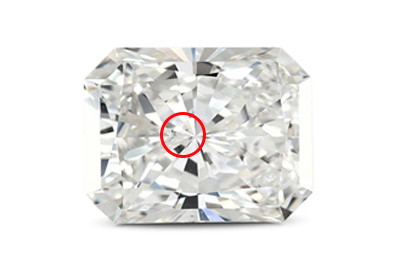
VS2 pear diamond
Pear diamonds are not common, and well-cut pear diamonds are even less well common. So, finding your perfect VS2 pear diamond that is both eye clean, has a good shape and doesn’t exhibit any bow tie can be difficult.
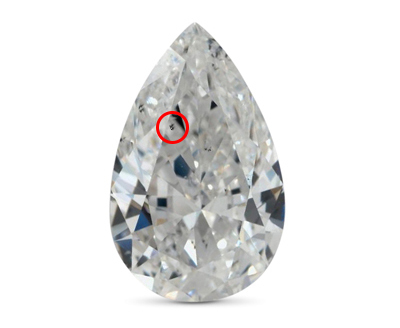
Pear diamond with some inclusions under the table, but good shape and no bow tie.

Pear diamond with no inclusions under the table, but less good shape (sides are overly rounded) and visible bow tie.
With some diamond shapes, it can be about finding the best balance of small compromises that works.
VS2 asscher cut diamond
Asscher cut diamonds are what is known as a ‘step cut’ rather than a ‘brilliant cut’, like a round or a princess cut diamond. What this means is that instead of having a large number of facets that reflect light at different angles, they have a lower number of long, straight facets that are all aligned and which lights bounces off.
This means that Asscher cut diamonds are less good at hiding inclusions, and even those aren’t underneath the table and may have been difficult to see in other diamond shapes are more readily seen in a VS2 Asscher cut diamond.

VS2 Emerald diamond
The emerald cut diamond is another step cut, like the Asscher above. Unlike the Asscher though, the emerald cut has an extremely large top table. In fact, the emerald cut diamond has the largest table as a percentage of its face up area.
What this means is the VS2 emerald cut diamonds are more likely to have their inclusions under the table, rather than hidden under the pavilion.
VS2 emerald cut diamonds should therefore be examined very carefully before purchase and I would not recommend buying an VS2 emerald cut diamond unless you are certain will be eye clean.
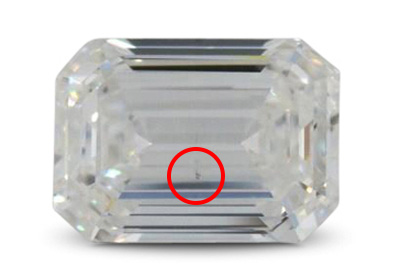
VS2 Heart diamond
Heart diamonds are one of the rarest diamond shapes, and like the pear diamond it can be a case of finding the best compromise between the shape of the diamond and the clarity.
Because heart diamonds are difficult to cut well (many are cut to maximise the carat weight, rather than for the beauty of the stone), there are often slim pickings of good-looking VS2 clarity heart shaped diamonds to choose from. The key to finding the right stone is likely to be patience, and not settling for a poorly cut stone or one with an obvious inclusion.
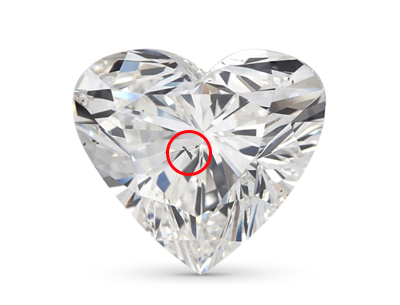
VS2 Marquise Diamond
Marquise diamonds have one of the largest ‘spreads’ of any diamond shape, which means that they look the largest when mounted in a ring setting.
But they actually have a relatively small top table, compared to other elongated shapes like the oval and emerald cut. What this means is inclusions are much less likely to appear under the table than the other elongated shapes.
The marquise is also a brilliant cut, which means that its facets should be optimised to work together to deliver incredible sparkle back to you and hide any inclusions. All of this means that selecting a VS2 clarity marquise diamond should be a pretty safe bet to be eye clean.
The biggest battle may be ensuring that your VS2 clarity marquise diamond isn’t just eye-clean for clarity, but also does not have a significant bow tie

Eye-clean VS2 marquise diamond with no bow tie
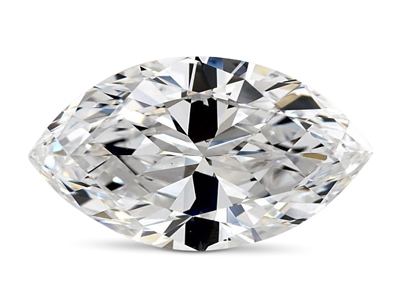
Eye clean VS2 diamond with severe bow tie
Where to buy VS2 diamonds
If you’re buying a diamond or an engagement ring in a bricks and mortar store, diamond clarity is often the thing that the salesman will focus on. They will show you diamonds under a microscope or through a loupe and point out inclusions that are possible to see when the stone is magnified, but which would be impossible to see without magnification.
But, once you know it’s there, it can be tricky to still choose that stone.

I am a big advocate of buying diamonds and engagement rings online, due to the huge choice available to select from, the lack of sales pressure and the greater value for money that online retailers offer.
If you’re buying a VS2 diamond then I recommend checking out James Allen’s range as they have the highest quality images of diamonds available.

